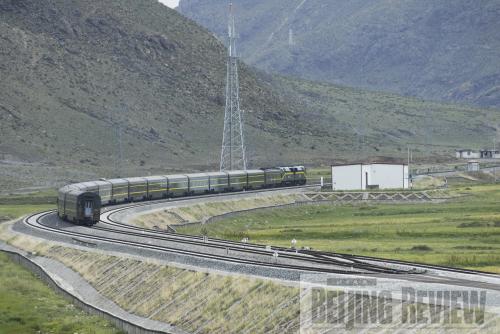|
 |
|
LOW IMPACT: The Qinghai-Tibet Railway, after operating for three years, has proven to be an environmentally responsible railroad on the roof of the world (WEI YAO) |
One of the major concerns about the Qinghai-Tibet Railway when it was under construction was whether its operation would harm the environment along the tracks.
"After three years of operations, this railway has proven to be as environmentally friendly as we promised," said Zhang Yongze, Director of the Environmental Protection Bureau of the Tibet Autonomous Region.
Even before construction began, eight large-scale assessments were conducted along the railway. Protection specialists created several plans to conserve the vulnerable Tibetan ecosystem and a variety of its wildlife. The final plans they chose were those that could minimize environmental damage.
They changed the direction of the proposed track to go around a natural reserve area instead of cutting directly through it to protect black-necked cranes, increasing its length by 30 km. The change added 300 million yuan ($43.9 million) to construction costs. Passageways were set up at 33 locations to allow the safe movement of wildlife, and construction stopped during important migration periods.
A number of bridges totaling more than 150 km in length were built to protect the wetlands on the Qinghai-Tibet Plateau. To minimize damage to the wetlands, engineers created areas by the side of the railroad where they transplanted the turf dug up for construction. The sewage generated during the construction was treated to meet the state's discharge standards and then used to water green spaces.
"It was a very tough task," said Zhang. "But it is all worthwhile. Almost all the passengers are amazed by the sight of the wildlife wandering through the green grass out of the window."
Statistics provided by the Environmental Protection Bureau show that a total of 1.4 billion yuan ($205 million) has been invested in environmental protection along the 1,142-km-long railway, which accounts for almost 5 percent of the project's total cost. That is the highest proportion ever spent on conservation in China's railway construction history.
The Qinghai-Tibet Railway Co. was set up in 2002 to manage the construction and operation of the Gela section (from Golmud in Qinghai Province to Lhasa) of the railway. A company official, Li Li, told Xinhua News Agency that they built a 600-km-long green belt covering 4.5 million square meters along the railway. Meanwhile, the Gela section has been using pollution-free energy, such as electricity and solar energy for heating. The Lhasa Railway Station, for instance, uses light diesel oil for fuel.
Since the Qinghai-Tibet Railway started operations, every train running on the line has been equipped with sewage and garbage collectors. There are garbage-collecting vehicles at Golmud and Lhasa to treat the refuse collected from trains.
The garbage on the sealed trains is collected in plastic bags and left at stations along the plateau for batch treatment. Meanwhile, seven stations were established along the line, each of which is responsible for railway logistics and operations in an 80 km radius. Wherever possible, remote or automatic control and maintenance have been adopted to reduce the impact and the number of staff on the Qinghai-Tibet Plateau.
In addition, 15 wastewater treatment plants were set up along the Gela section and are monitored every month to ensure that sewage is discharged according to required standards.
Almost all land along the Qinghai-Tibet Railway has been made green. Bare earth has been covered so that the rails are difficult to spot from a distance. In 2007, the Tibet local government created the Qinghai-Tibet Railway Environment Monitoring Mechanism to conduct dynamic and continuous monitoring of the water, air, sound and ecology. | 